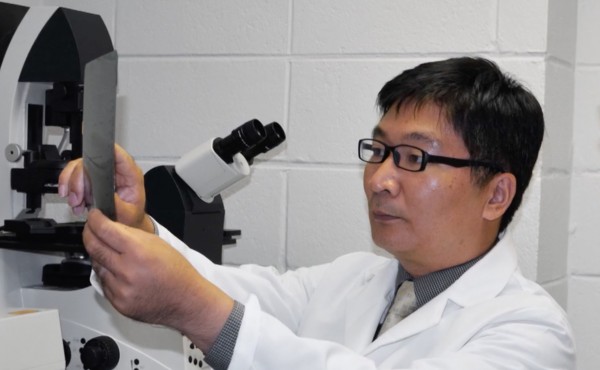Two out of three cancer patients are treated with radiation, but the therapy often fails to wipe out the tumor or slow its growth. Southern Research is working to develop a new class of drugs that will help the radiation deliver a more powerful punch to the disease.
Dr. Bo Xu, M.D., Ph.D., Distinguished Fellow and Chair of Southern Research’s Oncology Department, said a radiosensitizer, as this kind of drug is known, would greatly benefit cancer patients by improving the success rate of radiation by reducing resistance to the treatment.
“Our project focuses on making those tumor cells more vulnerable to radiation by targeting a critical survival mechanism that allows them to recover from the effects of radiation,” Xu said.
It’s a challenging project, in the works for almost a decade. It got started when Southern Research scientists began looking at fundamental biology concepts to identify a pathway that could play a role in the ability of cancer cells to survive radiation.

They discovered that disrupting the tumor’s self-protection mechanism – in this case, an interaction between two specific proteins – makes the cancer more sensitive to radiation treatment, Xu said.
“The whole idea is to use this strategy to find a new drug that can be used by patients who receive radiation. This drug wouldn’t have toxicity because if it got into the cell it wouldn’t mess up the major functions of the protein network,” he said.
“It would only work when radiation is delivered, and that radiation would be more effective. It’s like a catalyst.”
Using funding from the Alabama Drug Discovery Alliance (ADDA), a partnership with the University of Alabama at Birmingham, Southern Research scientists recently scanned thousands of compounds to identify potential drug candidates. The focus now is to validate the results of those scans and to identify lead compounds for more testing.
“Our hope is that in three years, we can identify a novel class of radiosensitizers that can help the approximately two-thirds of cancer patients who will eventually receive radiotherapy,” Xu said.
CRITICAL INTERFERENCE
While some forms of cancer, such as lymphoma, are sensitive to radiation therapy, many others are not. Solid tumors with a low supply of oxygen, called hypoxic tumors, are tough to treat with radiation. So are cancer cells with a high DNA-repair capability.
To develop a radiosensitizer, Xu is taking aim at a protein that binds to DNA and recognizes the damage being done by radiation. The protein then joins forces with an enzyme to initiate a molecular repair job.
“If that recruitment is successful, then the DNA damage will be repaired, and the cancer cell will survive,” Xu said. “What we’re trying to do is to block this protein from finding the other one, so that the repair process will be diminished or affected. That way, the tumor cells will die.”
To prevent the DNA repair job from getting started, Xu is investigating a small peptide mimic, a small sequence of amino acids that is similar to a human protein but just a fraction of its size. These strands get to the site to block the interaction of the two natural, full-size proteins.
“This interference makes the cancer cell more vulnerable to radiation treatment,” he said.
Radiosensitizers are in demand, but they have proved difficult to develop. While the concept has been around for half a century, very few radiosensitizers have actually become available, according to Xu.
“While there are compounds that work synergistically with radiation, there are few drugs that were developed as a pure radiosensitizer,” he said.
In addition to the ADDA, the National Institutes of Health and the Department of Defense prostate cancer program have provided Southern Research with funding for this research over the years.



